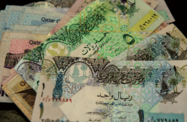International ratings agencies and analysts have given Qatar’s banking sector a clean bill of health, though the central bank is keeping an eye on non-performing loans (NPLs), as well as monitoring inflationary pressure.
In late June, international ratings agency Fitch said Qatar’s banks were set for a strong second half of 2011, with a number of factors in their favour, not least of which was the forecast for GDP to expand by 19% this year and 20% in 2012.
Higher government spending, especially on infrastructure, health care, education and tourism projects, will help underpin growth in the banking sector, Fitch said in a report issued on June 26. This could see the ratings of some Qatari lenders upgraded in the medium term, the agency said, so long as their asset quality was not eroded by rapid credit growth.
Ratings agency Moody’s agrees, saying in an investor note on July 7 that, “With projected GDP growth of approximately 15% per year and the additional stimulus of infrastructure investment for the 2022 FIFA World Cup, local banks will continue to benefit substantially from government-driven economic activity.” Fitch also cited the fact that most banks will see impairment charges ease later this year, with any downward pressure having been relieved, as another reason for optimism.
Though there has been an increase in the number of NPLs held by Qatari banks, overall levels are still assessed as being well within acceptable norms. Lenders have had to make provisions for $2.1bn for bad and doubtful loans, up from the $2bn as of the beginning of 2011, according to data released by Qatar Central Bank (QCB) in early July.
Financial services group Credit Suisse, in a report issued in mid-July, said Qatari banks were continuing to maintain high asset quality and commendably low levels of NPLs, with inactive credit lines representing just 1.7% of total portfolios at the end of last year.
Credit Suisse said that Qatar’s leading banks would see their NPL-to-asset ratio fall to 1.6% in 2012, while overall loan activity was projected to increase by 20.5% this year and 16.9% in 2012, the highest growth rate in the region.
The solid results in Qatar have not occurred by chance. A number of steps have been taken to ensure that the level of NPLs is kept in check. Banks have been instructed by QCB to establish internal units to oversee their respective loan activities and monitor how credit is disbursed and loans serviced. These departments are charged with rating and reviewing each loan account and assessing the creditworthiness of a borrower, the aim being to keep tabs on default levels, assess risk and keep NPLs at a minimum.
Qatar is also moving to reduce risk in the sector and build up the strength of its banking industry by fast-tracking plans to implement the Basel III accords, which will require lenders to hold top quality capital totalling 7% of their risk-bearing assets, up from the current 2%. Of that 7%, 4.5% comprises core tier 1 capital, which consists of shares and retained earnings, and the remaining 2.5% should be a capital conservation buffer. Other provisions under the new accords include mandating banks to hold sufficient high-quality liquid assets to cover their total net cash flows over 30 days and be better equipped to deal with extended periods of stress.
While the full requirements of Basel III are scheduled to come into force at the end of 2019, Qatar is looking to have them in place by 2013. Indeed, many of Qatar’s banks are able to meet most of the Basel III criteria already, with QCB saying in February that most were well placed with regard to capital adequacy rates.
While the overall outlook is positive, the concern that higher bank lending could fuel inflation remains. Loan activity increased by 15% year-on-year in May, according to official data, and although this is below most expectations for GDP growth, the continued strength of the economy, combined with rising consumer confidence, could cause a spike in demand, which in turn could push up the rate of inflation. Though this is still under 2%, the government and QCB will be wary that over-long lines of credit could see a return to double-digit inflation, as seen in the latter half of the last decade.
One way the QCB intends to combat this threat is by draining some liquidity out of the market through the issuance of treasury bills, and by keeping a close rein on the banks to ensure a balance is struck. In this way, the reserve can regulate the money market and maintain a steady flow of funds into the economy via the banks.

